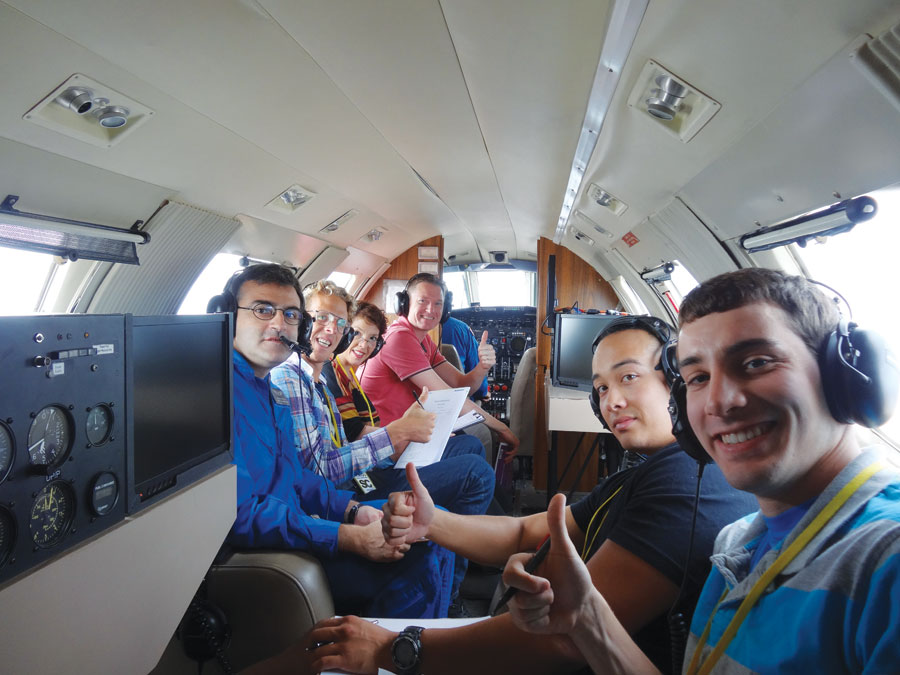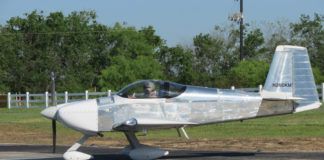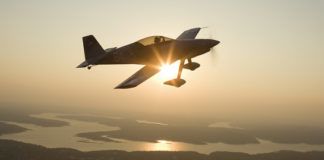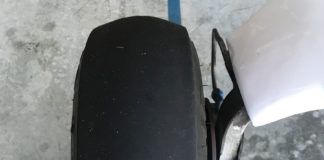My first solo flight lesson at the National Test Pilot School was the performance flight test technique flight, which was briefed by Russ Stewart, chief of fixed-wing instruction. Before Russ came to National, he was a handling qualities and performance test pilot on the A-10 joint test team, and before that, he was chief of academics at the U.S. Air Force Test Pilot School. Russ introduced us to the techniques that would be demonstrated during the flight, and I was particularly focused on level accelerations. I had read about the maneuver after it was described by friend and Airbus test pilot Terry Lutz, but never felt like I got my arms around it. I was surprised when Russ mentioned “anchoring the point,” a concept completely new to me.

The class tours one of the school’s many hangars. In this photo the variety of aircraft available for study is visible, from the pointy Aermacchi Impala and F-5 to the utility focused King Air and Sabreliner.
Anchoring the Point
A level accel starts with the airplane relatively slow (~1.3 VS). With enough power on the airplane to hold altitude, the pilot increases the power to full and focuses on holding altitude as the airplane accelerates out to VH (max level speed at full power). The problem is, VH is by definition asymptotic, and therefore, it takes a long time to get there. Anchoring the point is based on the idea that it is faster to decelerate back into that speed than to accelerate up to it. So when the speed is starting to stabilize, the pilot purposely dives the airplane to overshoot VH, then levels the airplane. At this point, the drag backs the airplane down to VH (faster than if the pilot had just waited for the excess thrust to get him there). My assumption is this technique is probably more of a pointy jet thing (in which Russ has a lot of experience), but is a great example of the kinds of lessons learned that can be transmitted when you get the right type of experience in the room.
Another great level accel technique that Russ shared (also related to fast jets) was that he liked to get the airplane stabilized before the point at low airspeed and low power somewhat below the target altitude. This meant he could use a short climb at that low speed after applying power to give the engine time to reach full thrust before leveling at the target altitude and allowing the airplane to start accelerating.
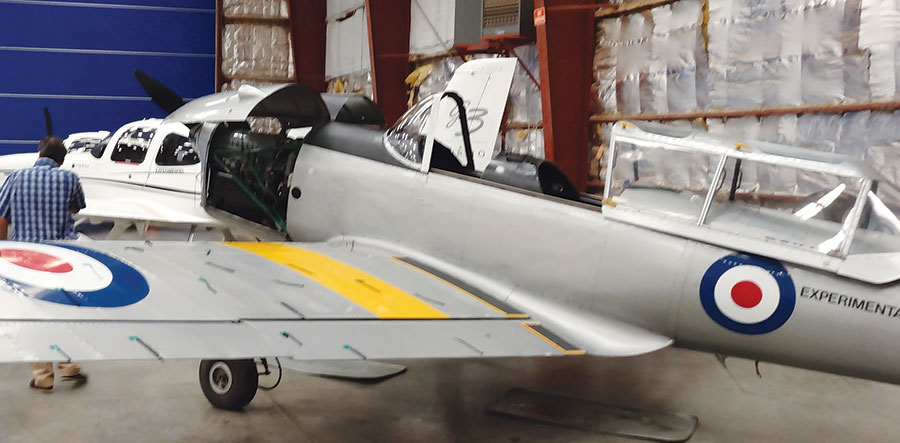
One of NTPS’s two de Havilland Chipmunks. The left wing’s tufts for stall testing can be seen in the photo. This Chipmunk is powered by the original Gipsy Major engine and has the original hand operated foot differentiated brakes. Such a cool airplane!
Performance Flight Test Technique
I flew the performance flight test technique solo lesson that Russ had briefed with Greg Lewis, and due to a convenient maintenance problem on the Cirrus in which I had been scheduled, I got to do the flight in one of the school’s two Gipsy Major powered de Havilland Chipmunks. I had never flown an airplane with hand actuated foot differentiated brakes before, nor had I flown a taildragger with a backwards turning propeller, so I was pretty excited. I found the solo flights to be interesting in a lot of the ways the course was interesting—it was another opportunity to watch professionals do the thing they are so trained at. Watching Greg’s mastery of the airplane as he efficiently moved through the test points was much more rewarding than trying to learn a new airplane and a new test technique, and seemed to be a much more efficient use of time. So on most of the points, I flew the point the first time, and then I asked Greg to demonstrate the point a second time while talking me through it. Besides the level accels, I had done most of the techniques before, so the value came from dialing in the details, and the reward came from watching a professional apply his trade.
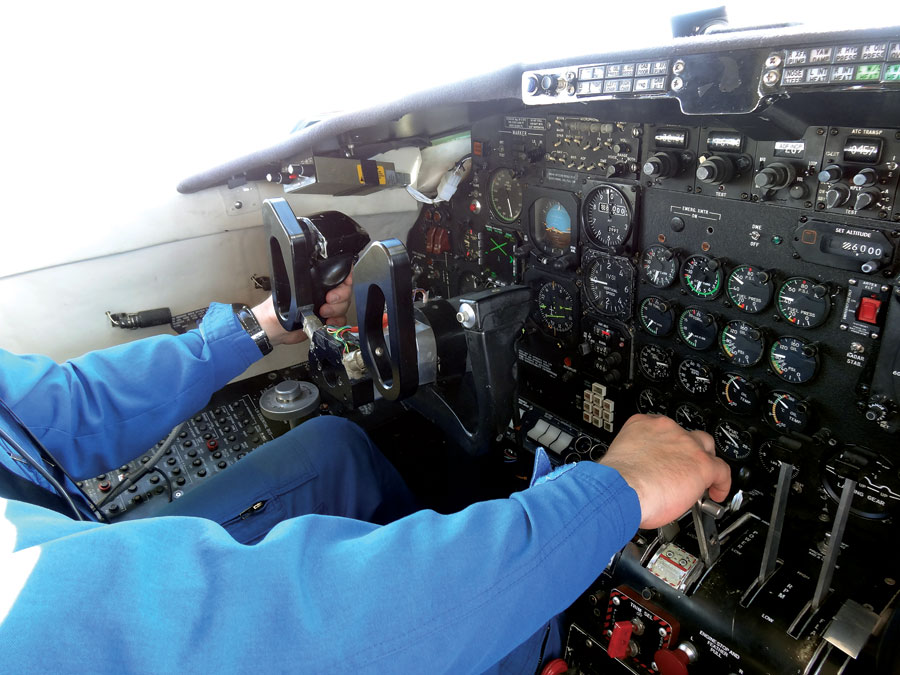
The Merlin’s instrumented yoke being flown by Nicola Pecile. The instrumented yoke is mounted on top of the original yoke connected by a series of load cells that measure the pitch and roll forces applied by the pilot. This instrument was built custom by the school and is a great example of the cool “Flight Test” things one gets to see at NTPS.
Static Longitudinal Stability
The fourth module in the flying classroom, static longitudinal stability, was flown by Greg. For these data flights a second yoke was mounted to the certified yoke of the Merlin. Between the two yokes a series of load cells measure the pitch and roll forces applied by the pilot. Plotting the forces against speed gives the stability of the airplane. By rearranging the students during flight according to body mass, we could measure the stability at two different CGs, which allowed us to plot the stability versus balance, and extrapolate the stick-free and stick-fixed neutral points.
Shortening the tail of the Metroliner to create the Merlin had direct effects on the airplane’s stability, which was fixed using a stability augmentation system (SAS) and stick pusher. The static longitudinal stability tests were the first chance we had to see the effects of this system. The Merlin’s SAS functions by increasing the stick force as a function of the relationship between indicated airspeed/alpha and stall speed/alpha, with the forces added increasing significantly as the airspeed slows to stall speed, eventually (at V/VS=1.02) activating the stick pusher (~50 pounds). By performing stick force and stick position versus airspeed sweeps, with and without the SAS engaged, the effects of the system could be clearly seen by the students. This provided great insights into the importance of stick-free stability.
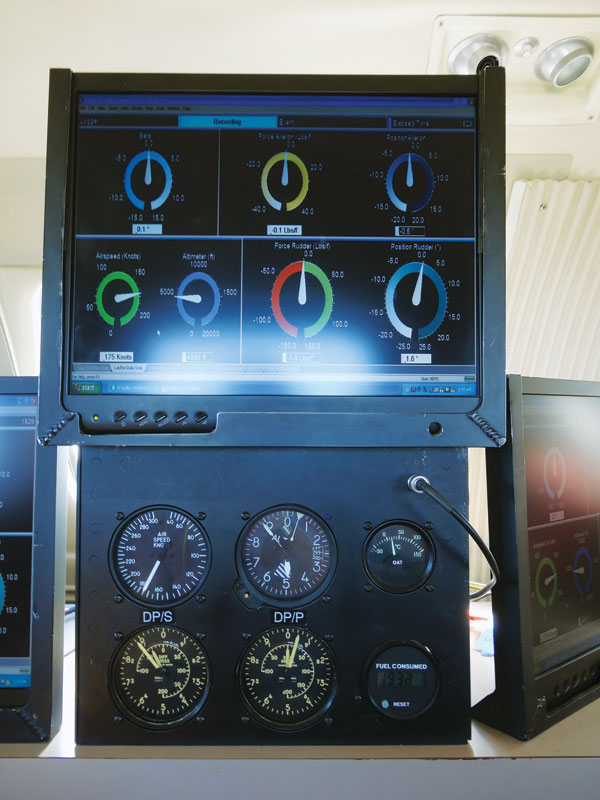
The flying classroom includes two custom-built displays for the students to gather data. The top display can be changed to indicate the different variables required for the different modules, while the bottom display gives the steam gauge alternative for the pitot static modules.
Maneuvering Stability
For the fifth flying module we expanded the longitudinal stability work to include maneuvering stability. We measured maneuvering stability using two different methods. The first was a standard windup turn, which is the way I was taught. The windup turn gives the pilot lots of time to get stabilized before recording the data. The alternative method to a windup turn is the push-pull technique, which I had never seen before. The push-pull method is done wings level, varying climb rate to allow for a couple seconds of stabilized positive or negative vertical acceleration. Because the time available is very short, pilot technique becomes very important. Yannis Tsolekas was pilot on this flight. He is a fixed-wing test pilot instructor and came to NTPS after working as a test pilot for six years at the Greek Air Tactics Center, including F-4 and F-16 test work.
Instructor Marco Lotterioa noted during this flight a slight difference in crew resource management between Yannis and Greg. The pilot in the Merlin doesn’t have a G meter, so Greg liked Marco to call out G on the intercom. By comparison, Yannis found the intercom G callouts distracting and not fast enough to be useful, so instead, he liked to fly the point with intercom silence. Then between points he would ask what G he had stabilized at, and he would use that data as a reference for his next point. It was a subtle but powerful lesson on how a team might adjust for flying styles or instrumentation subtlety.
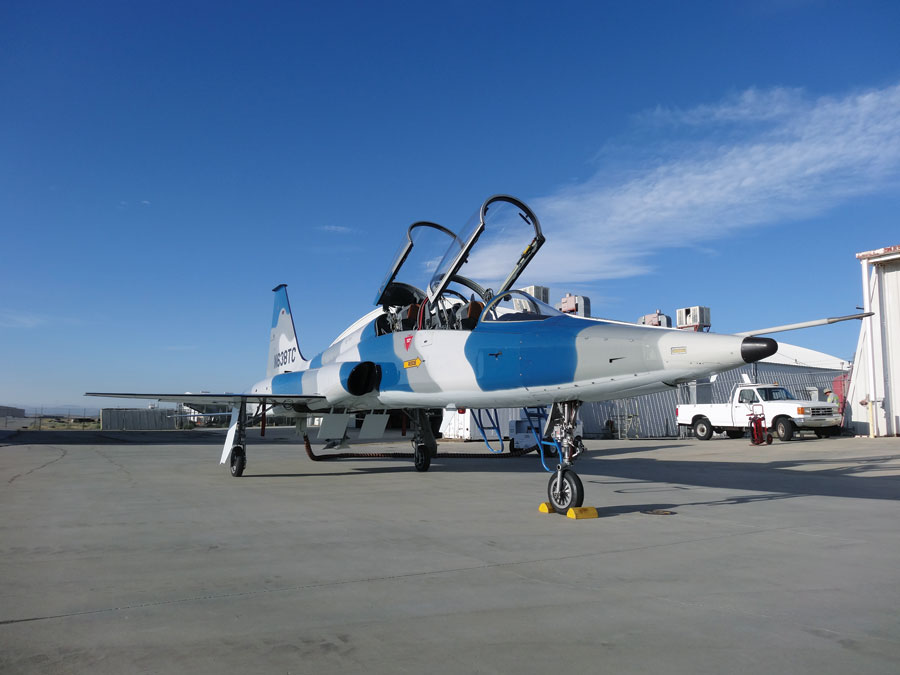
The National Test Pilot School recently traded in their aging Saab Drakens for a Northrop F-5. This aircraft is used for the supersonic portions of the curriculum. In engineering school we had a wind tunnel; this is much cooler!
Lateral-Directional Stability
The lateral-directional stability module (Merlin flight six) was the first time we saw the yaw damper’s behavior in the data, and the stall module was the second. By comparing the Dutch roll damping ratio with and without the yaw damper engaged, it became very clear both why Dutch roll was important and how useful the SAS was at damping it out.
The wing pickup demonstrations illustrated clearly the Merlin’s rudder-aileron interconnect. This led to many fruitful debates about the utility of dihedral effect and whether that utility was preserved with an aileron interconnect. Specifically it could be argued that the reason we want dihedral effect is in the event of an aileron jam, it gives the pilot a redundant means of lateral control. Therefore, is this utility lost if the interconnect requires the ailerons to be free for them to be signaled by the rudder?
Regardless of the results of that particular debate, this was the kind of discourse that was so valuable during the course. As Marco says, a good team includes three to five test pilots (in this case students), each with a different background, and the diversity of that experience makes for better feedback on a system, the clearest example being the relative required stability of a long-range bomber versus a short-range fighter.
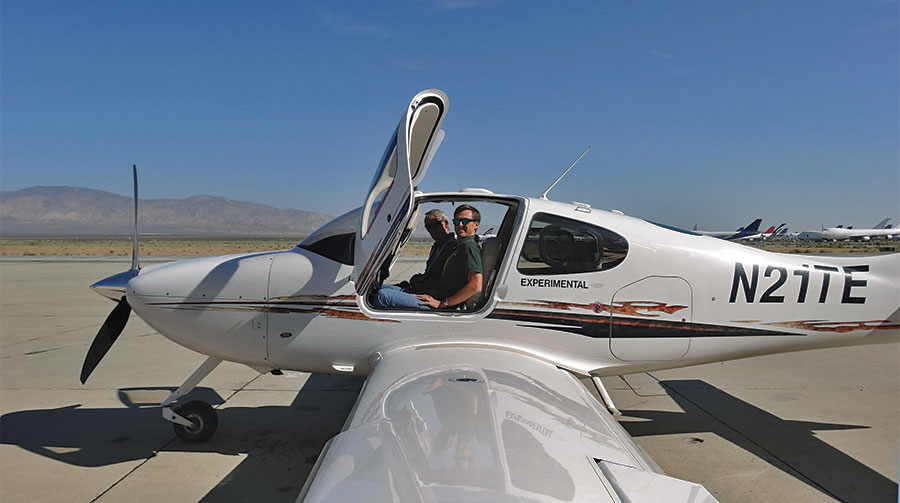
Elliot Seguin and Greg Lewis prepare for the second flight test technique sortie. This Cirrus features a rare FADEC- controlled single-lever IO-550.
Flying Qualities Flight Test Technique
The second solo flight was the flying qualities flight test technique demonstration flight. Like the other solo flight, this demonstration was oriented toward a non-pilot engineer, but once again Greg was willing to adjust to accommodate my background. Due to another favorable scheduling conflict I got to fly the school’s FADEC (single lever) IO-550-powered SR-22, which was full of “gee-whiz glass,” as instructor Russ Stewart would say.
The FADEC’s performance was pretty seamless. The only time it really came up was initial power reduction after takeoff. The engine was making 25 inches manifold pressure turning 2700 rpm, and the checklist said to pull the power back to 2500 rpm. An rpm checklist item stood out to me because there was no propeller lever. So I pulled the power lever back, and the rpm came back to 2500. When I overshot, the FADEC held the rpm and started reducing manifold pressure. Pretty cool!
The test card repeated the static longitudinal and maneuvering longitudinal stability (both windup and push-pull) card we had flown in the Merlin. It also included the lateral-directional, Dutch roll, short period, phugoid, spiral, roll time constant, and stall points. Once again the pace was fast, and I took every opportunity to have Greg fly the point after I did to maximize what could be learned.
When I had done stall testing for customers, I never appreciated the purpose of CFR 23.201 (rate of speed reduction will not exceed one knot per second) is to keep the manufacturer from using pitch rate to artificially lower the published stall speed. The pitch rate creates momentum that pulls the nose up and deeper into the stall than would occur under static conditions, another tidbit to take home.
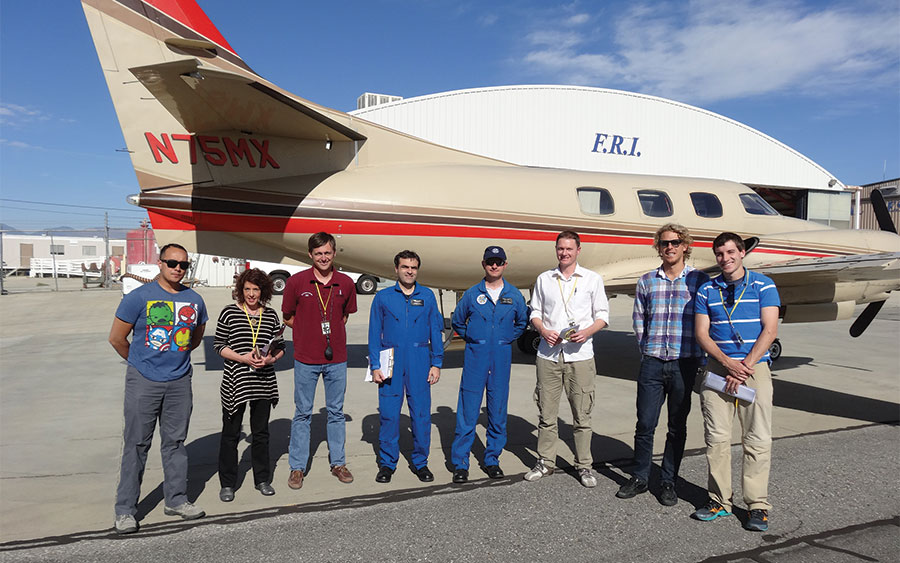
The class gathers with instructors (in their blue flight suits) Marco Lotterio (left) and Nicola Pecile (right) next to the school’s Merlin flying classroom. What an awesome experience!
Stall and Dynamics
The final flight module in the Merlin was the stall and dynamics flight (Merlin flight seven). It was the most aggressive flying we did during the course. The flight was flown by Nicola Pecile, who by this time had accepted his new job as experimental test pilot at Virgin Galactic, flying SpaceShipTwo (congratulations Nicola!).
The stall matrix had four configurations: power off/no flaps, power on/no flaps, power off/50% flaps, power off/full flaps. Because the airplane has such poor directional stability (Metroliner tail on a shorter fuselage), the Merlin is known for a strong tendency to drop a wing. We saw 30 degrees of wing drop during power on/flaps up.
CFR 25.201 (d) describes the acceptable indications of a stall. It does not include wing drop. Therefore, the CFR implies, and it is generally considered good practice, that the longitudinal response to the stall significantly precedes the lateral-directional response. Because a wing drop like the Merlin’s is not acceptable, the fix the engineers at Swearingen used was an angle of attack signalled stick pusher. When the SAS senses the airplane is approaching stall (V/VS=1.02), the stick pusher adds a 50-pound nose-down force, which is maintained until the aircraft accelerates (V/VS>1.12).
After the stalls, the dynamics flight was a quick survey of the dynamic characteristics of the airplane. We started with the phugoid response, with and without the SAS. The effects were very noticeable, unfavorably changing the damping ratio by a factor of 4. This is an unintended side effect of the SAS, which increases the apparent stick-free stability (by artificially increasing stick force) while decreasing the speed stability. As a result, the SAS reduces the phugoid damping ratio.
The directional stability augmentation (yaw damper) could also clearly be seen in the dynamic responses of the aircraft. The Dutch roll damping ratio went from well damped (6) with the yaw damper on to very lightly damped (0.1) damper off. This is by design as the yaw damper was added specifically to address the Dutch roll characteristics. The aircraft demonstrated certifiable spiral stability, with the right bank stability being neutral and the left bank being unstable (asymmetric due to P-factor), but within limits of CFR 25. When asked about the value of spiral-mode testing Nicola said, “Spiral mode is a very stupid mode, no one regulates against it.” This was great flight test context.
Short Period Frequency Sweep
The single most informative demonstration of the course for me was the short period frequency sweep demonstration. This was something I had read and reread in every test textbook I could get my hands on, but never felt like I really understood. The combination of a well thought out lecture delivered by Marco and watching Nicola fly the point was eye opening.
Similarly, I have been very confused by every discussion I have had on roll time constant. In this case, I was equally enlightened by the course material, but interestingly there was no flying component. When I asked Nicola why he didn’t demo the timed roll maneuvers referenced in the course material and described in many other books, he replied quickly and with conviction, “Because they don’t work.” This was the single best example of the difference between school and reading about this stuff in a book. I don’t know that there is punctuation available to express the confidence in the subject matter that Nicola conveyed in that moment.
Closed Loop Handling Qualities
The most rewarding lecture was one of Marco’s last lectures of the week. It took us through the core of his area of expertise, closed loop handling qualities. Working only for small companies, my flight test experience is almost exclusively rooted in reversible flight control systems. I assumed this meant I didn’t know anything about this topic.
Marco says, “The most complicated feedback loop is the one that includes the pilot.” Marco’s ability to move conversationally through this material flipped the topic on its head. Another favorite quote: “Fly-by-wire flight control testing is more dependent on good test pilots than standard flight controls. When the computer can make the airplane do anything, it becomes that much more important to understand what the pilot is asking for.”
Marco has spent the majority of his career developing tests to evaluate handling tweaks on a pilot’s ability to perform a task. He talked about the relationship between the engineer and the pilot that write the test and how important their communication is, and how important it is that a different pilot flies the test and describes how he performs. As the Cooper-Harper rating scale (see sidebar) shows, the pilot may perform well, but be absolutely saturated or vice versa. Only the pilot can provide the feedback because only the pilot knows how hard they were working and how hard they expected to be working. This insight into a kind of testing I had never witnessed was yet another example of what the school offers—a diverse sampling of backgrounds from the test community under one roof.
The Snake Barrel
The two-week course (80 hours) included 46 hours of class time, 8 hours of flight time, and 26 hours of lab time. The rate of data transfer and the quality of the information were both very high. If it takes a hundred hours of building for every 10 hours designing in order to get an hour testing, then flight test becomes, like air-to-air combat, a skill that is as intricate as it is infrequently practiced.
Skip Holm says flutter is like dealing with a barrel full of rattlesnakes: If you put your hand in and pull it right back out, you might get through it. If you put your hand in and kick the barrel—you are dead. In other words, a test pilot should limit the time spent in a risky environment (in this case flutter) when that risk cannot be directly controlled in another way. Therefore, the 100-10-1 rule works to the advantage of most pilots; skilled or not, they are unlikely to spend much time in the snake barrel because most flying is done away from the edges of the envelope, even in Experimentals. However, a tester by definition lives in the barrel, and therefore, it is our responsibility to be aggressive about learning whenever the opportunity presents itself.
NTPS is a great example of a place full of resources dedicated to teaching the skills directly related to test. It was right under my nose, and I’m glad I finally was able to take advantage of it. This is good work that we do—cold and unforgiving, but good.

![]()
Elliot Seguin is a homebuilder, engineer, and test pilot based at the Mojave Civilian Flight Test Center in California. He is a member of the Society of Experimental Test Pilots and each year he competes in Wasabi, the IF1 racer he designed, at the Reno National Championship Air Races. He is also a Test Pilot for Aerochia Performance Aircraft and is a project engineer and flight test engineer at Scaled Composites, founded by Burt Rutan.


